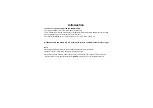
Typical Configurations
17
SYSTEM CONFIGURATIONS
The MiVoice Business product line includes a number of platforms, IP phones, and applications.
Each platform is designed for a different business segment and size, but each contains a number
of common components. The main difference between the units is the quantity of components
contained in each.
The units are flexible and can be used in a number of different configurations, for example:
•
IP-PBX with phones, Voice Mail, and PSTN gateway
•
Standalone controller, in conjunction with other units
•
Standalone PSTN gateway
•
Standalone Voice Mail
•
Standalone wireless gateway
•
Standalone IP network gateway
•
Standalone Teleworker gateway
•
Resiliency backup controller
•
TDM controller for legacy interfaces (e.g. SX-2000 Light Peripheral and DSU cabinets).
The use of the LAN infrastructure and IP networking allows the units to be installed and used
in a number of different configurations. It also allows for a more distributed architecture and
dispersal of equipment compared to a more traditional central TDM PBX system.
MiVoice Business has a reliable, mature call control with a large feature set enabling multiple
integration possibilities with an existing installation.
The remainder of this chapter describes typical configurations, and provides some sample
configurations. “Configuration Tables” on page 32 show the maximum capacity for each feature
or resource for each type of controller.
For more information on the following topics that may affect the system configuration, see:
•
3300 ICP Technician’s Handbook
for Slot Number convention
•
3300 ICP Hardware Technical Reference Manual
for external interfaces and external TDM
interfaces.
Note:
Refer to “Migrate SX-2000 PBX Hardware” in the
3300 ICP Technician’s
Handbook
for detailed instructions.
Содержание MiVOICE BUSINESS
Страница 1: ...Mitel MiVoice Business RELEASE 7 2 ENGINEERING GUIDELINES ...
Страница 15: ...Chapter 1 ABOUT THIS DOCUMENT ...
Страница 16: ......
Страница 22: ...Engineering Guidelines 8 ...
Страница 23: ...Chapter 2 SYSTEM OVERVIEW ...
Страница 24: ......
Страница 28: ...Engineering Guidelines 14 ...
Страница 29: ...Chapter 3 TYPICAL CONFIGURATIONS ...
Страница 30: ......
Страница 73: ...Chapter 4 PHONES AND VOICE APPLICATIONS ...
Страница 74: ......
Страница 95: ...Phones and Voice Applications 81 Figure 9 ICP Connection Paths and Limitations ...
Страница 100: ...Engineering Guidelines 86 ...
Страница 101: ...Chapter 5 POWER ...
Страница 102: ......
Страница 128: ...Engineering Guidelines 114 ...
Страница 129: ...Chapter 6 PERFORMANCE ...
Страница 130: ......
Страница 135: ...Chapter 7 APPLICATIONS ...
Страница 136: ......
Страница 142: ...Engineering Guidelines 128 ...
Страница 143: ...Chapter 8 EMERGENCY SERVICES ...
Страница 144: ......
Страница 151: ...Chapter 9 IP NETWORKING ...
Страница 152: ......
Страница 167: ...Chapter 10 LICENSING ...
Страница 168: ......
Страница 183: ...Chapter 11 BANDWIDTH CODECS AND COMPRESSION ...
Страница 184: ......
Страница 209: ...Chapter 12 NETWORK CONFIGURATION CONCEPTS ...
Страница 210: ......
Страница 244: ...Engineering Guidelines 230 ...
Страница 245: ...Chapter 13 NETWORK CONFIGURATION SPECIFICS ...
Страница 246: ......
Страница 309: ...Appendix A CAT 3 WIRING ...
Страница 310: ......
Страница 315: ...CAT 3 Wiring 301 Figure 55 CX MX MXe AX and LX Minimum Cable Standard ...
Страница 316: ...Engineering Guidelines 302 ...
Страница 317: ...Appendix B INSTALLATION EXAMPLES ...
Страница 318: ......
Страница 335: ...Appendix C LLDP AND LLDP MED CONFIGURATION EXAMPLES ...
Страница 336: ......
Страница 347: ...Appendix D VOIP AND VLANS ...
Страница 348: ......
Страница 353: ...Appendix E VOIP SECURITY ...
Страница 354: ......
Страница 381: ... ...
















































